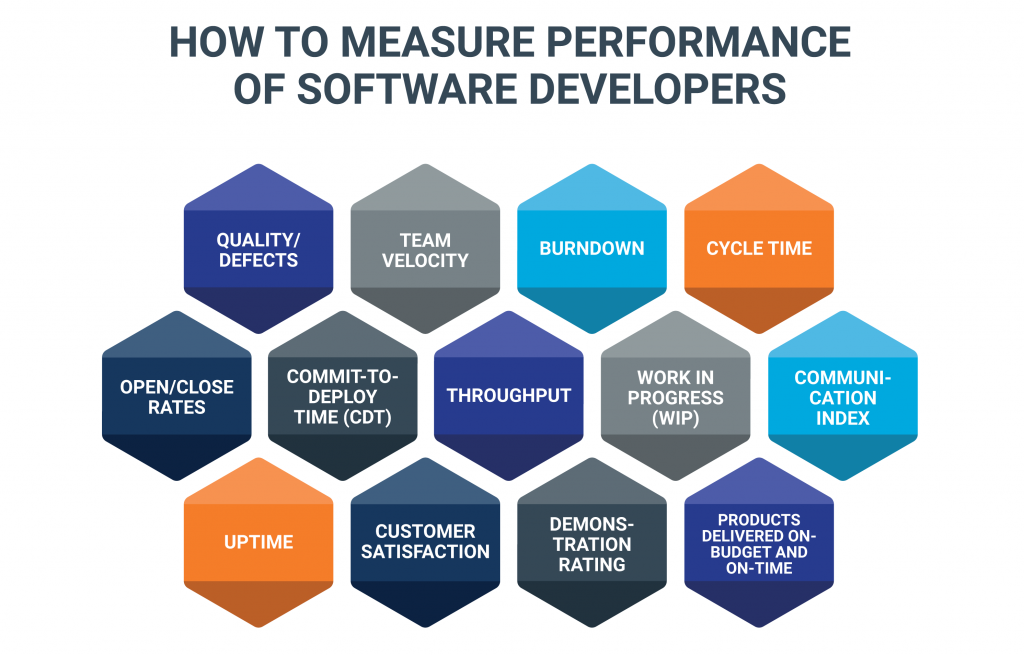Agile development metrics
Baselining your agile development process allows you to measure progress, identify areas for improvement, and ensure that your team is working efficiently. Here are some key metrics to help you baseline your agile development process:

Velocity: This metric measures the amount of work your team completes during each sprint (or iteration), typically represented in story points or hours. It helps you gauge the team’s capacity and predict how much work they can handle in future sprints.
Sprint Burndown: The sprint burndown chart tracks the remaining work in a sprint, showing how quickly tasks are being completed. It helps you visualize progress and identify if your team is on track to meet sprint goals.
Lead Time: This measures the time it takes for a work item to go from being added to the backlog to being completed. It helps you understand how quickly your team is delivering value to customers and how efficient your development process is.
Cycle Time: This metric tracks the amount of time it takes for a work item to go from starting work on it to completing it. It helps you identify bottlenecks and inefficiencies in your development process.
Work In Progress (WIP): This measures the number of tasks currently being worked on by the team. Keeping WIP limited can improve focus and throughput, while reducing the risk of multitasking and context-switching.
Cumulative Flow Diagram (CFD): This visual representation of work in progress, completed tasks, and tasks in the backlog helps you identify bottlenecks, monitor flow, and ensure that work is moving smoothly through the process.
Escaped Defects: This metric tracks the number of defects found in production after a release. It helps you understand the quality of your team’s output and identify areas where additional testing or process improvements are needed.
Team Satisfaction: Regularly surveying your team’s satisfaction and engagement levels can provide valuable insights into team dynamics and potential areas for improvement.
Time to Market: This measures the time it takes for a product or feature to go from inception to being available to customers. It can help you understand how effectively your team is delivering value to your customers.
Release Frequency: This metric tracks the number of releases or deployments your team makes over a given time period. Increasing release frequency can help improve product quality and customer satisfaction.
Remember that these metrics are just a starting point for baselining your agile development process. It’s important to tailor them to your specific context and adjust them as needed to ensure that they are providing the insights you need to continuously improve.
How can we get better?
Improving the metrics associated with your Agile development process often involves refining your team’s practices and focusing on continuous improvement. Here are some strategies to help you improve these metrics:
Set clear goals and expectations: Define realistic and achievable goals for each sprint, and ensure that all team members understand and are aligned with them. This can help improve velocity, sprint burndown, and time to market.
Prioritize the backlog: Regularly review and prioritize your product backlog to ensure that your team is working on the most valuable items. This can help improve lead time, cycle time, and time to market.
Limit work in progress (WIP): Encourage the team to focus on completing tasks before starting new ones. This can help reduce multitasking and context-switching, improving cycle time and overall efficiency.
Use short, time-boxed iterations: Shorter sprints or iterations help the team maintain focus, adapt to changing requirements, and iterate quickly. This can lead to better velocity, lead time, and release frequency.
Improve communication and collaboration: Foster a culture of open communication and collaboration within the team and with stakeholders. This can help identify bottlenecks, improve decision-making, and ultimately improve metrics like cycle time and lead time.
Implement continuous integration and continuous delivery (CI/CD): Automating build, test, and deployment processes can help catch defects early, reduce manual effort, and increase release frequency.
Invest in training and skill development: Provide your team with opportunities to learn and grow their skills. This can lead to improved performance and satisfaction, ultimately impacting most metrics positively.
Monitor and address technical debt: Regularly review and address technical debt to prevent it from slowing down development or causing defects. This can help improve velocity, lead time, and escaped defects.
Conduct regular retrospectives: Hold retrospectives after each sprint to identify what worked well, what didn’t, and what can be improved. Use this feedback to continuously refine your agile processes and practices.
Optimize team size and composition: Experiment with different team sizes and roles to find the optimal balance for efficiency and communication. This can help improve velocity, cycle time, and overall team satisfaction.
Remember that improving these metrics should not be the sole focus of your agile development process. Instead, use them as a tool to help guide your continuous improvement efforts and to ensure that your team is consistently delivering value to your customers.
Conclusion
In conclusion, monitoring and improving key metrics in your agile development process is crucial for ensuring that your team is consistently delivering value to customers, working efficiently, and maintaining a high level of quality.
By setting clear goals, prioritizing the backlog, fostering collaboration, investing in continuous improvement, and addressing potential bottlenecks, you can create an environment where your team thrives and continuously improves.
Remember that these metrics should serve as a tool to guide your efforts and inform your decision-making, rather than becoming the sole focus of your development process. By maintaining a balanced approach and focusing on delivering value, you can achieve long-term success in your agile development endeavors.